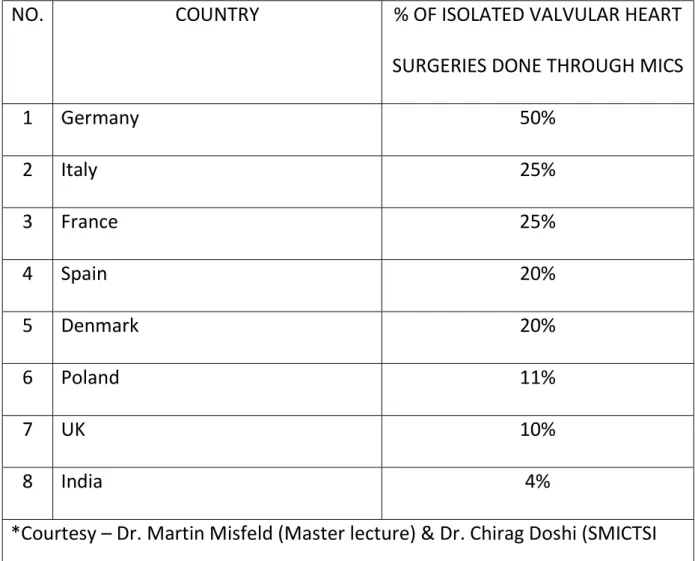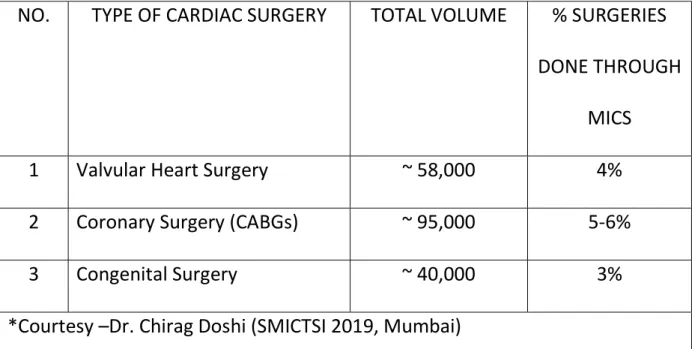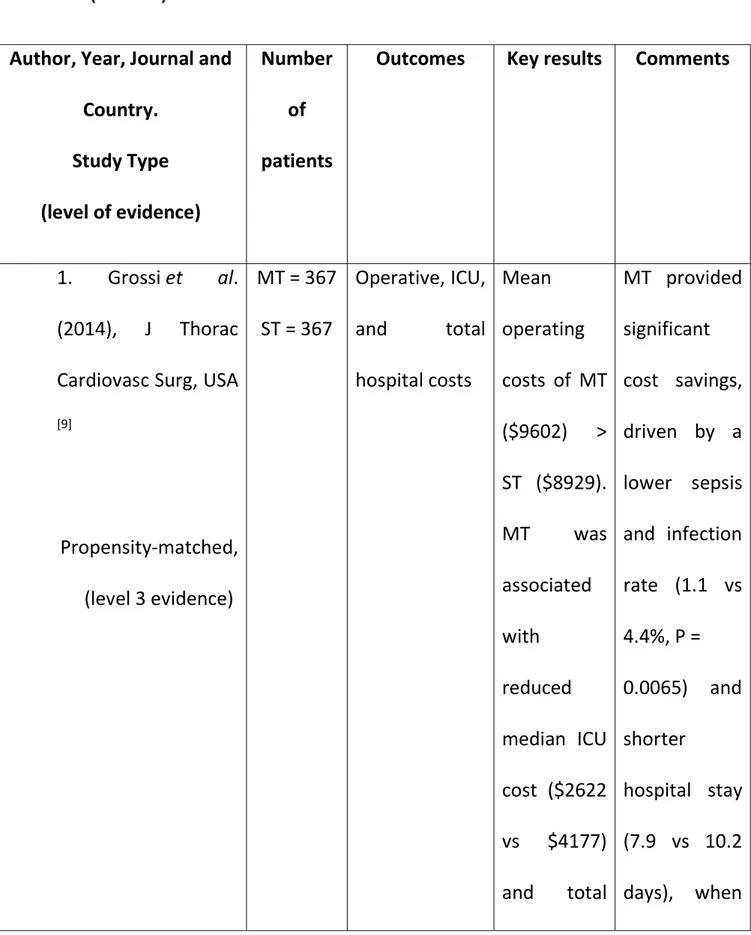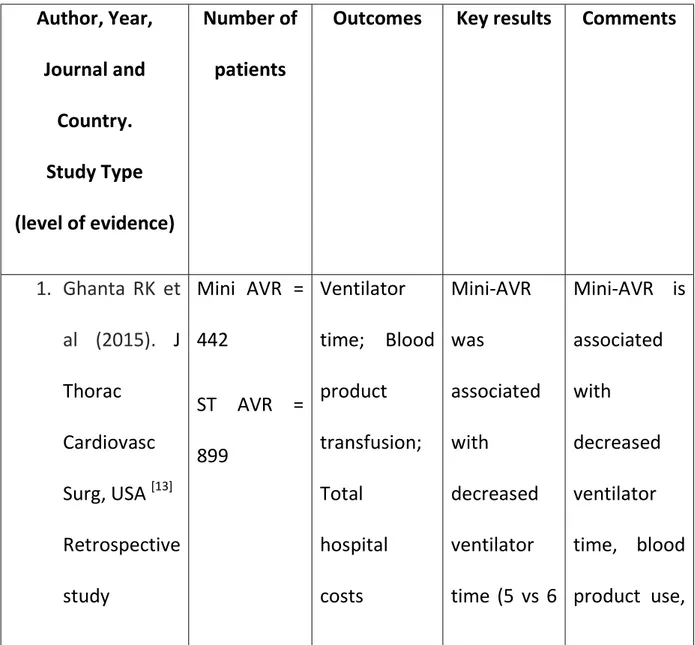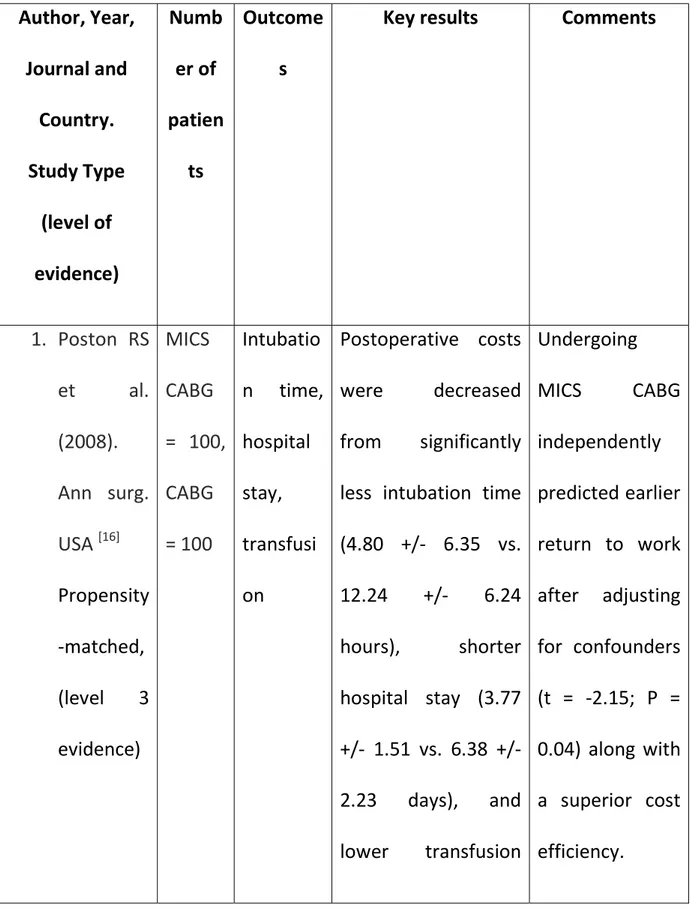311ModFTPW/EN00
Second Level Master in
“Innovation in Cardiac Surgery: advances in minimally invasive therapeutics” Academic Year
2017/2018
LOGO MASTER
(se disponibile)
Analysis of the logistical, economical and
minimally invasive cardiac surgical training
difficulties in India:
A systematic review of literature
Author
Dr. Ganesh Kumar K Ammannaya
Scientific Tutor
Prof. Dr. Claudio Passino
Company Tutor
Prof. Dr. Marco Solinas
Director, Ospedale del Cuore – Massa, Fondazione Toscana G. Monasterio
1
ABSTRACT:
BACKGROUND:
Significant inroads and advancements have been made in Minimally invasive cardiac surgery (MICS) over the past 3 decades. However, the acceptance and practice of MICS continues to remain rather low in the developing world owing to several challenges – economical, logistical and paucity of training opportunities.OBJECTIVES:
The objective of this study was to analyse the logistical, economical and training difficulties in MICS with a special focus on the Indian scenario.METHODS:
A systematic review of the current literature on MICS with an emphasis on the economical, logistical and training challenges was done on the basis of pertinent studies and database studies retrieved by a selective search in the MEDLINE/PubMed Central and EMBASE/SCOPUS databases as well as by the Google Scholar search engine.RESULTS:
A PubMed search employing the search term “minimally invasive cardiac surgery” yielded nearly 11,694 hits. All studies carrying relevant data from these databases were pooled in for this study. Minimally invasive mitral valve surgeries (MIMVS), minimally invasive aortic valve replacement (MIAVR/mini-AVR) and MICS coronary artery bypass grafting (CABG) have been2
shown to have a clear cost-benefit advantage that stems from shorter ICU and hospital stay, lesser transfusion requirements and avoidance of sternal wound complications. However, only limited reports are currently available detailing the economical and training challenges for the application of MICS in the developing world, particularly India. These reports highlight the reasons for the low rate of MICS practice in India and also offer solutions to overcome these challenges such as public-private partnerships and the introduction of training curriculum for MICS in India to avoid the over dependence on foreign fellowships which not many can afford.
CONCLUSION:
Several challenges exist in widening the practice of MICS in India which are mainly economical and lack of training facilities. However, these can be overcome through certain target-oriented steps with the aid of public sector which can foster a lasting partnership with the private healthcare and by the setting up of training curriculum as well as skills laboratories and simulation centres to roll out MICS surgeons to meet the needs of present day cardiac surgery.KEY WORDS: minimally invasive cardiac surgery, minimally invasive
mitral valve surgery, coronary artery bypass grafting, minimally
invasive aortic valve replacement
3
TABLE OF CONTENTS:
1. INTRODUCTION...4
2. METHODS...8
3. RESULTS...10
3.1
MINIMALLY INVASIVE MITRAL VALVE SURGERY (MIMVS)
VS CONVENTIONAL MITRAL VALVE SURGERY...10
3.2
MINIMALLY INVASIVE AORTIC VALVE SURGERY VS
CONVENTIONAL AORTIC VALVE SURGERY...15
3.3
MINIMALLY INVASIVE CORONARY ARTERY BYPASS
GRAFTING (CABG) VS CONVENTIONAL CABG...20
3.4
MICS IN INDIA – THE CURRENT STATE OF AFFAIRS FROM
THE ECONOMICAL, LOGISTICAL AND TRAINING
PERSPECTIVES...23
4. DISCUSSION...28
5. CONCLUSION...32
4
1. INTRODUCTION
The first foray into MICS-mitral valve surgery were simultaneously reported by Cosgrove [1] and Cohn et al. [2] and into aortic valve surgery by Cosgrove and Sabik [3] in 1996. Subsequently, video assistance was introduced
by Carpentier et al. [4], transthoracic aortic clamping by Chitwood et al. [5],
port-access by the Leipzig group headed by Mohr et al. [6] and robotic computer assisted surgery by Carpentier et al. [7].
As we stand today, most intracardiac pathologies have a parallel minimally invasive or transcatheter solution to the standard sternotomy route. MICS has been continuously gaining traction, so much so that, in some centres across the world, MICS is a default strategy for most cardiac surgeries. MICS thus seems to be finding favour with the patients who are demanding these lesser invasive procedure and also the industry seems to be willing to sponsor it.
It’s a no brainer that MICS has several advantages - a certain cosmetic advantage, reduces blood loss and transfusion requirements, shortens the length of hospital stay and avoids the potentially devastating infective problems of mediastinitis/sternal dehiscence besides reducing the post-operative recovery time and early return to work [8].
5
The level of acceptance of MICS in some of the major emerging economies such as India compares rather dismally with the European countries. This is summarized from pooled data as shown in Table 1.
TABLE 1: PERCENTAGE OF VALVULAR HEART SURGERIES PERFORMED THROUGH MICS – EUROPE VS INDIA
NO. COUNTRY % OF ISOLATED VALVULAR HEART
SURGERIES DONE THROUGH MICS
1 Germany 50% 2 Italy 25% 3 France 25% 4 Spain 20% 5 Denmark 20% 6 Poland 11% 7 UK 10% 8 India 4%
*Courtesy – Dr. Martin Misfeld (Master lecture) & Dr. Chirag Doshi (SMICTSI 2019, Mumbai)
6
As evident from the table above, the level of acceptance and application of MICS seems to be the highest in Germany where 50% of isolated valvular heart surgeries were performed through MICS in the year 2016 (about 8500 off a little over 17,000 cases). These rates have increased in particular over the past 10 years. In comparison to the European nations, the practice of MICS in India is still at its infancy.
From the various pooled in data, a rough estimate of the percentage of MICS being performed in India for the various cardiac surgeries in India is presented in Table 2.
TABLE 2: PERCENTAGE OF HEART SURGERIES PERFORMED THROUGH MICS – INDIAN SCENARIO
NO. TYPE OF CARDIAC SURGERY TOTAL VOLUME % SURGERIES DONE THROUGH
MICS 1 Valvular Heart Surgery ~ 58,000 4% 2 Coronary Surgery (CABGs) ~ 95,000 5-6%
3 Congenital Surgery ~ 40,000 3%
7
From the above table, it is clear that the scope for scale up of MICS in India is tremendous. About 58,000 valvular heart surgeries are performed in India as against about 17,000 in Germany; but the absolute numbers performed through MICS compares as follows : 2300 (India) Vs 8500 (Germany). In other words, with over three times the patient volume, the number of MICS valvular surgeries in India are performed three times less frequently. Hence, we can safely conclude that, the scenario in India is ripe for the introduction of MICS and a huge scale up subsequently.
However, the challenges are huge. With the rapid strides made by MICS, few pertinent questions that need to be asked are: Do the extensive economic and logistical resources required for these surgeries justify their propagation in developing countries ? How do these less invasive surgeries compare with conventional sternotomy approach with respect to economic viability ? Being technically demanding, can MICS be taught with a reasonable learning curve without compromising patient’s interests ? Therefore, this study was performed with the objective of exploring the various difficulties, challenges and feasibility of the application of MICS with respect to its economics, logistics and training in India.
8
2. METHODS
A systematic and structured review of the current literature on MICS with
an emphasis on the economical, logistical and training challenges was done on the basis of pertinent studies and database studies retrieved by a selective search in the MEDLINE/PubMed Central and EMBASE/SCOPUS databases as well as by the Google Scholar search engine.
Separate keywords were entered each time to obtain specific information such as – “economics of minimally invasive mitral valve surgery”/ “cost benefit analysis of minimally invasive mitral valve surgery”, “economics of minimally invasive aortic valve surgery”/ “cost benefit analysis of minimally invasive aortic valve surgery”, “economics of minimally invasive CABG”/ “cost benefit analysis of minimally invasive CABG”/ “economics of MICS CABG”/ cost benefit analysis of MICS CABG”. Furthermore, Boolean operator “AND” was used to extract information and data pertaining to India as follows - “economics of minimally invasive cardiac surgery AND India”/ cost benefit analysis of minimally invasive cardiac surgery AND India” and “training of minimally invasive cardiac surgery AND India”.
The references of identified articles were reviewed to detect relevant information and to identify any additional related articles. Studies not
9
published as full-text articles, single case reports and articles not written in English were excluded. No article was excluded based on publication date.
10
3. RESULTS
As of 31 August 2019, searches of the databases yielded nearly 11,694 hits. However, Only limited reports were available detailing the economical and training challenges for the application of MICS in the developing world, particularly India. All studies carrying relevant data from these databases were pooled in for this study.
3.1 MINIMALLY INVASIVE MITRAL VALVE SURGERY (MIMVS) VS CONVENTIONAL MITRAL VALVE SURGERY
The results of the review of the economical analysis of minimally invasive mitral valve surgery (MIMVS) Vs conventional mitral valve surgery is summarized in Table 3. Since 1998, at least four studies have shown a clear cost-benefit of MIMVS. The lower cost entailed in MIMVS stems from the fact that these patients require a shorter hospital stay, fewer blood transfusions, improved resource utilization and lower sepsis/avoidance of sternal wound complications.
11
TABLE 3: ECONOMICAL ANALYSIS OF MINIMALLY INVASIVE MITRAL VALVE SURGERY (MIMVS) VS CONVENTIONAL MITRAL VALVE SURGERY
Author, Year, Journal and Country. Study Type (level of evidence) Number of patients
Outcomes Key results Comments
1. Grossi et al. (2014), J Thorac Cardiovasc Surg, USA
[9] Propensity-matched, (level 3 evidence) MT = 367 ST = 367 Operative, ICU, and total hospital costs Mean operating costs of MT ($9602) > ST ($8929). MT was associated with reduced median ICU cost ($2622 vs $4177) and total MT provided significant cost savings, driven by a lower sepsis and infection rate (1.1 vs 4.4%, P = 0.0065) and shorter hospital stay (7.9 vs 10.2 days), when
12 hospital cost ($31,515 vs $37,495), when compared with ST compared with ST. Furthermore, Lower readmission rates observed in MT at 30 days (26.2 vs ST 35.7%, P < 0.0052) and 90 days (31.6 vs 44.1%, P < 0.0005) may translate into additional cost savings 2. Iribarne et al. (2012), MT = 70 ST = 105 Total hospital cost MT $37,069 vs ST MT was associated
13 J Thorac Cardiovasc Surg, USA [10] Retrospective study (level 3 evidence) $43,790, P = 0.007 with reduced hospital costs, driven by decreased length of hospital stay and improved resource utilization and postoperative functional status when compared with ST. Length of hospital stay MT 5.1 ± 0.9 vs ST 8.6 ± 0.6
14 days, P = 0.033. 3. Gersak et al. (2005), Heart Surg Forum, Slovenia [11] Retrospective study (level 3 evidence) Minimally invasive port-access MV surgery = 105; ST = 110 Mean costs of hospitalization, Units of blood transfused and Hospital length of stay The average total patient cost was 20% less for the port-access group, P < 0.0005. Port-access 2.1 vs ST 3.6 units, P < 0.0001. Port-access 5.1 vs ST 8.6 days, P < 0.0001. Port-access surgery was associated with significant reductions in resource utilization and costs.
15
al. (1998),
Ann Thorac Surg,
USA [12] Retrospective study (level 3 evidence) ST = 40 cost, Hospital length of stay MT ($5800) vs ST ($6250), after removing the costs of prosthetic valves; MT 5.7 vs ST 6.2 days (P = not significant); complications in MT, including 0% mortality, 14% incidence of required blood transfusions and relatively shorter length of hospital stay. * MT – mini thoracotomy; ST – sternotomy
3.2 MINIMALLY INVASIVE AORTIC VALVE SURGERY VS CONVENTIONAL AORTIC VALVE SURGERY
The results of the review of the economical analysis of minimally invasive
16
Table 4. Studies performed by Ghanta RK et al. and Rodriguez E et al. have shown a clear cost benefit of mini-AVR Vs full sternotomy AVR in terms of reduced ICU and hospital stay and decreased transfusion requirements. Hassan M et al. further showed that the cost saving is further much greater in mini sternotomy AVR as compared to right anterior thoracotomy (RAT) AVR.
TABLE 4: ECONOMICAL ANALYSIS OF MINIMALLY INVASIVE AORTIC VALVE SURGERY VS CONVENTIONAL AORTIC VALVE SURGERY
Author, Year, Journal and Country. Study Type (level of evidence) Number of patients
Outcomes Key results Comments
1. Ghanta RK et al (2015). J Thorac Cardiovasc Surg, USA [13] Retrospective study Mini AVR = 442 ST AVR = 899 Ventilator time; Blood product transfusion; Total hospital costs Mini-AVR was associated with decreased ventilator time (5 vs 6 Mini-AVR is associated with decreased ventilator time, blood product use,
17 (level 3 evidence) hours; P = .04) and decreased blood product transfusion (25% vs 32%; P = .04). Total hospital costs were lower in the mini-AVR group ($36,348 vs $38,239; P = .02). early discharge, and reduced total hospital cost.
18 al. (2015). Journal of Heart Valve Disease. USA [14] Retrospective database-based study. (level 3 evidence) was compared with MST AVR through 8 reports from the United States were selected from amongst 33,494 literature citations based on sample size blood transfusion; Length of hospital stay was associated with lower rate of blood transfusion (25.9% versus 64.4%), and a shorter length of hospital stay (5.7 versus 6.2 days). benefits of MST AVR are comparable or better than those of RAT AVR at lower costs. Assuming a volume of 50 cases per year, the added operative cost per case for a RAT AVR was US$ 4,254
compared to US$ 290 for
19 a MST AVR. The added costs per case, assuming 200 cases per year, were US$ 4,209 and US$ 290, respectively. 3. Rodriguez E et al. (2014). J Med Econ. USA [15] Propensity-matched, (level 3 evidence) RAT = 1572 ST = 3962 (Propensity matched – 921 patients each) Blood product cost; Overall hospital cost Less blood product cost associated with RAT ($1381 vs $1912; p < 0.001). Less cost and ICU time with RAT-AVR Vs ST-AVR.
20 RAT-AVR associated with lower cost than ST-AVR ($38,769 vs $42,656; p < 0.01).
* RAT – right anterior thoracotomy; MST – mini sternotomy; ST - Sternotomy
3.3 MINIMALLY INVASIVE CORONARY ARTERY BYPASS GRAFTING (CABG) VS CONVENTIONAL CABG
The results of the review of the economical analysis of minimally invasive
coronary artery bypass grafting (CABG) Vs conventional CABG is summarized in Table 5. Poston et al. showed that MICS CABG was associated with earlier return to work along with significant hospital savings arising out of shorter intubation time, shorter hospital stay and lower transfusion requirements. In an earlier study by King RC et al., authors showed a cost-benefit advantage of MICS CABG Vs both PTCA and conventional CABG.
21
TABLE 5: ECONOMICAL ANALYSIS OF MINIMALLY INVASIVE CORONARY ARTERY BYPASS GRAFTING (CABG) VS CONVENTIONAL CABG
Author, Year, Journal and Country. Study Type (level of evidence) Numb er of patien ts Outcome s
Key results Comments
1. Poston RS et al. (2008). Ann surg. USA [16] Propensity -matched, (level 3 evidence) MICS CABG = 100, CABG = 100 Intubatio n time, hospital stay, transfusi on Postoperative costs were decreased from significantly less intubation time (4.80 +/- 6.35 vs. 12.24 +/- 6.24 hours), shorter hospital stay (3.77 +/- 1.51 vs. 6.38 +/- 2.23 days), and lower transfusion Undergoing MICS CABG independently predicted earlier return to work after adjusting for confounders (t = -2.15; P = 0.04) along with a superior cost efficiency.
22
requirements (0.16 +/- 0.37 vs. 1.37 +/- 1.35 U).
Analysis with the groups stratified according to risk revealed that MICS CABG had a significantly more favourable cost efficiency (0.62 ± 0.16 vs. 0.81 ± 0.17; P <0.05) and profit margin (25,132 ± 6086 vs. 15,653 ± 8141; P = 0.01) 2. King RC et al. (1997). MICS CABG Total hospital
Total hospital costs for the MICS CABG
MICS CABG is clearly cost
23 Heart Surg Forum. USA [17] Retrospec tive study. (level 3 evidence) = 9 CABG = 9 PTCA = 10
costs and PTCA groups were significantly less when compared with those of standard CABG ($11, 233, $12,152, vs. $18,859 respectively, p = 0.0028). effective when compared with that of PTCA and conventional CA BG.
* MICS CABG – Minimally invasive cardiac surgery coronary artery bypass grafting; PTCA – percutaneous transluminal coronary angioplasty.
3.4 MICS IN INDIA – THE CURRENT STATE OF AFFAIRS FROM THE ECONOMICAL, LOGISTICAL AND TRAINING PERSPECTIVES
The low level of MICS embracement in India is due to the high initial capital intensive investment during the setting up of a new MICS centre [18]. There have been few bright spots of how MICS was successfully introduced.
Reddy SC et al. [19] report in their article dated 2013, of how MICS was
24
year 2012-13. These included – 25 MIMVR, 10 mini-AVRs, 30 ASD closures and 5 MICS CABG. The team faced significant challenges with 2 cases requiring conversion to sternotomy, about 10 patients developed minor air leak which subsided spontaneously, a case of right lower limb edema related to femoral vein cannulation and another case of surgical site infection. However, the overall results were encouraging and the team carried on and has been performing about 80-100 cases of MICS annually.
Today, of the nearly 2,00,000 cardiac surgeries that are performed in India, only about 11000-12000 cases are done through the MICS route. Of nearly 700 cardiac centres in India, only about 90 have attempted or have performed cases of MICS either regularly or irregularly, which accounts for
only about 12-13% attempt rate for MICS. Mishra YK [20] has given a pragmatic
and a highly feasible solution to up this number through his concept of –
“Public-Private Partnership (PPP)”. Public-private partnership (PPP) model is a
clever policy to utilize the excellence of booming private tertiary care centres in India for the poor people. The government, thus, could have a win-win deal for every one because it can avoid the investment and maintenance cost of infrastructure and protecting precious tax payers’ money, while private tertiary care hospitals get increased demand for advanced facilities by the addition of government sponsored patients, though at a skewed profit margin. It also
25
keeps the bed and staff engaged. On the flip side, there are issues of heavy paper work, delayed passages of bills and payments. These, if looked into and rectified, a flourishing PPP model can be created in India and the practice of MICS in India can approach the European standards over the coming 3-5 years. Certain other indigenous methods have also been put to practice in the Indian scenario to circumvent the higher cost of peripheral cannulation. Kandakure PR et al. [21] report the routine use of direct cannulation in MICS in
centres with limited resources to mitigate the cost as regular instruments and cannulae are used. Over a 2 year period (January 2017 – December 2018), the authors report a total of 140 cases of MICS (ASD closure (53%), Mitral Valve Repair (14%), VSD closure (9%), Aortic valve replacement (10%), Mitral valve replacement (6%), Repair of PAPVC (9%), Myxoma excision (1%), VSD closure with pulmonary valvotomy (1%)), being performed with central cannulation. Similarly, Kale SB et al. [22] reported 145 cases of MICS performed through October 2015 – March 2017, without peripheral cannulation. The cases operated included those performed through right anterior thoracotomy - MIMVR, ASD closures, VSD closures and correction of TOF. Right anterior thoracotomy without peripheral cannulation was found to be safe and effective for the correction of a wide range of congenital heart defects including right ventricular outlet obstructions.
26
Endoscopic cardiac surgeries are nearly non-prevalent in the country owing to the extremely high costs of the initial set up that ranges between € 75,000-1,00,000 and a high number of cases required for the breakeven. These can be aimed as a gradual progression from thoracotomy, once an existing MICS centre gains experience and begins delivering results that, are at par with the standards of today.
Another major detriment to the successful application of MICS on a large scale is the lack of training facilities [20]. Training infrastructure in India is
limited and there are no skills laboratories with advanced simulation based teaching facilities including premier institutes and some of the best heart centres. Moreover, there is not a single fellowship programme dedicated to MICS in the country. Therefore, there are neither formal nor informal training opportunities for MICS in India in the present moment and all interested surgeons have no choice but to embark on foreign fellowships either in the US or Europe to learn these advanced techniques. Therefore, it is of utmost importance to introduce training curriculums for MICS in India so as to avoid the over dependence on foreign fellowships which not many can afford. The governing medical bodies of country must take note of the changing needs in the practice of cardiac surgery and address the issue by offering training facilities through ushering new fellowship programmes and also setting up
27
skills laboratories and simulator centres to help further shorten the learning curve [20].
28
DISCUSSION
From the several aforementioned studies it can be safely concluded that
MICS has a distinct economic advantage with respect to overall lower hospital costs. This has been shown in MIMVR, mini-AVR and MICS CABG and also MICS in general. However, most of these studies are performed in the USA. More such studies are needed particularly in the developing countries such as India, which would help impress these facts and help the faster spread of MICS in India.
Education regarding the cost-benefit of MICS especially in the post-operative course and early return to work resulting in higher efficiency needs to be spread in the Indian scenario to draw more surgeons into the MICS mainstream. Further, a conducive atmosphere of an amicable public private partnership can help greatly strengthen the logistics of MICS practice in India. The state of cardiac surgery in the developing countries is ripe for the era of MICS. Careful patient selection aiming to “tailor the operation to the patient and not the patient to the operation” is the crux of a successful MICS program. India has been an ideal place for excellent cost-effective medical treatments, particularly for the patients from SAARC countries, Africa, Middle-east, and Central Asia. India is a leading developing nation which has
29
participated in achieving the goals laid down under the Millennium Development Goals—2015, Vision—2020 and subsequently under the Sustainable Development Goals—2030. Recently, the Indian government has been appreciated for its effort in bringing down the cost of devices. India has also launched the “Ayushman Bharat” or “Modi Care” which is being hailed as the largest public sector health cover in the world by the prestigious Lancet journal. Therefore, the future holds great promise and this opportunity needs to be seized by the present generation of cardiac surgeons. We are thus at a critical and strategic inflection point in the evolution of cardiac surgery. It has been challenged both by our cardiology counter parts, as also a self-challenge within the cardiac surgical community, more as a survival response than anything else. We thus need to evolve continuously and keep reinventing ourselves rather than repeat the mistake of 1970s and 1980s of developing the ‘inertia of success’.
A target oriented approach has to formulated by the major governing medical bodies of the country to improve teaching and training facilities. These should include facilitating research and development, performing multicentric studies to better understand the Indian scenario, more workshops and simulation based hands on experience or skills laboratories designed to hone the skills required for MICS and also on hybrid technologies like wires and
30
catheters. Introduction of indigenous fellowship programmes under the mentorship of existing MICS surgeons is the need of the hour. Also, trainees may be allowed to go and work in another centre in or out of India, for at least 4 weeks to enhance training experiences, which can be sponsored by the medical college hospitals and the industry alike.
New MICS surgeons can continuously monitor their own progress and learning curve or can be looked upon by the heads of the department through CUSUM curve analysis, which is a simple statistical method [23]. It will be successful if surgeons embrace new technologies in imaging, videoscopy, and catheter-based interventions. Technology transfer at regional and global platform and transferring effective technology from developed centres to centres of learning and reducing import duties and levies on implantable coronary and other devices and machines can further go a long way in achieving the goals of a much wider application and practice of MICS in India. Minimally invasive cardiac surgery has been seen to flourish in heart team environments as evident in Western Europe. The same has to inculcated in India. Finally, there is a strong need of database. There have been successful efforts to create a global database for the cardiac surgeries like STS database, however, the lack of national databases in India is hurting the realistic
31
monitoring of the growth of MICS and the evaluation of its results vis-à-vis conventional cardiac surgeries.
32
CONCLUSION
There is no denying that several challenges do exist in the successful
application and practice of MICS in India on a large scale. These are mainly economical, logistical and the lack of training facilities and programmes. However, these can be overcome through a strong-willed target oriented approach with the aid of public sector which can foster a lasting partnership with the private healthcare and also by the setting up of training curriculums as well as skills laboratories and simulation centres to roll out MICS surgeons to meet the needs of present day cardiac surgery.
33
BIBLIOGRAPHIC REFERENCES
1. Cosgrove DM. Minimally invasive mitral valve operations. Ann Thorac
Surg. 1996; 62:1542–1544.
2. Cohn LH, Adams DH, Couper GS, et al. Minimally invasive cardiac valve
surgery improves patient satisfaction while reducing costs of cardiac valve replacement and repair. Ann Surg. 1997; 226:421–428.
3. Cosgrove DM 3rd, Sabik JF. Minimally invasive approach for aortic valve
operations. Ann Thorac Surg. 1996; 62:596–597.
4. Carpentier A, Loulmet D, Carpentier A, et al. Open heart operation under
videosurgery and minithoracotomy – First case (mitral valvuloplasty) operated with success. CR Acad Sci. 1996; 319:219–223.
5. Chitwood WR Jr, Elbeery JR, Chapman WH, et al. Video-assisted
minimally invasive mitral valve surgery: the ‘micro-mitral’ operation. J Thorac Cardiovasc Surg. 1997; 113:413–414.
6. Mohr FW, Falk V, Diegeler A, Walther T, van Son JA, Autschbach R.
Minimally invasive port-access mitral valve surgery. J Thorac Cardiovasc Surg. 1998; 115:567–576.
7. Carpentier A, Loulmet D, Aupècle et al. Computer assisted open heart
surgery—First case operated on with success. CR Acad Sci III. 1998; 321:437–442.
34
8. Yamada T(1), Ochiai R, Takeda J, Shin H, Yozu R. Comparison of early
postoperative quality of life in minimally invasive versus conventional valve surgery. J Anesth. 2003; 17(3):171-6.
9. Grossi EA, Goldman S, Wolfe JA, Mehall J, Smith JM, Ailawadi G et al.
Minithoracotomy for mitral valve repair improves inpatient and postdischarge economic savings. J Thorac Cardiovasc Surg 2014; 148:2818–22.
10. Iribarne A, Easterwood R, Russo MJ, Chan EY, Smith CR, Argenziano M.
Comparative effectiveness of minimally invasive versus traditional sternotomy mitral valve surgery in elderly patients. J Thorac Cardiovasc Surg. 2012; 143:S86–90.
11. Gersak B, Sostaric M, Kalisnik JM, Blumauer R. The preferable use of port
access surgical technique for right and left atrial procedures. Heart Surg Forum. 2005; 8:354–63.
12. Cosgrove DM III, Sabik JF, Navia JL. Minimally invasive valve
operations. Ann Thorac Surg. 1998; 65:1535–8.
13. Ghanta RK, Lapar DJ, Kern JA, Kron IL, Speir AM, Fonner E Jr, Quader
M,Ailawadi G. Minimally invasive aortic valve replacement provides equivalent outcomes at reduced cost compared with conventional aortic
35
valve replacement: A real-world multi-institutional analysis. J Thorac Cardiovasc Surg. 2015 Apr; 149(4):1060-5.
14. Hassan M, Miao Y, Maraey A, Lincoln J, Brown S, Windsor J, Ricci M.
Minimally Invasive Aortic Valve Replacement: Cost-Benefit Analysis of Ministernotomy Versus Minithoracotomy Approach. J Heart Valve Dis. 2015 Sep; 24(5):531-9.
15. Rodriguez E, Malaisrie SC, Mehall JR, Moore M, Salemi A, Ailawadi
G,Gunnarsson C, Ward AF, Grossi EA; Economic Workgroup on Valvular Surgery. Right anterior thoracotomy aortic valve replacement is associated with less cost than sternotomy-based approaches: a multi-institution analysis of 'real world'data. J Med Econ. 2014 Dec; 17(12):846-52.
16. Poston RS, Tran R, Collins M, Reynolds M, Connerney I, Reicher B, Zimrin
D,Griffith BP, Bartlett ST. Comparison of economic and patient outcomes with minimally invasive versus traditional off-pump coronary artery bypass grafting techniques. Ann Surg. 2008 Oct; 248(4):638-46.
17. King RC, Reece TB, Hurst JL, Shockey KS, Tribble CG, Spotnitz WD, Kron
IL. Minimally invasive coronary artery bypass grafting decreases hospital stay and cost. Ann Surg. 1997 Jun; 225(6):805-9; discussion 809-11.
36
18. Yadava OP. Minimally invasive cardiac surgery—a push to kaizen! Indian
Journal of Thoracic and Cardiovascular Surgery. May 2018; 34 (Suppl 2):S81–S83.
19. Reddy SC, Parimi SS, Tella R, Chunduru K, Syed NA. Initiating a minimally
invasive cardiac surgery program–challenges and solutions. Indian J Thorac Cardiovasc Surg. 2013; 29: 98.
20. Mishra YK. Quest of affordable cardiac care with public-private
partnership: a way forward to the future! Indian Journal of Thoracic and Cardiovascular Surgery. April–June 2019; 35(2):139–145.
21. Kandakure PR, Batra M, Garre S, Nagendra S, Shaikh F, Pani K. Direct
Cannulation in Minimally Invasive Cardiac surgery with limited resources. Ann Thorac Surg. 2019 Jul 20. pii: S0003-4975(19)31041-0. doi: 10.1016/j.athoracsur.2019.05.075.
22. Kale SB, Ramalingam S. Minimally Invasive Cardiac Surgery Without
Peripheral Cannulation: A Single Centre Experience. Heart Lung Circ. 2018 Sep 12. pii: S1443-9506(18)31892-4. doi: 10.1016/j.hlc.2018.08.018.
23. Wu, Xianqiu et al. Analysis of the Learning Curve in Mitral Valve
37
Approach: A Surgeon’s Experience with the First 100 Patients. Heart, Lung and Circulation. March 2019; 28(3): 471 – 476.
